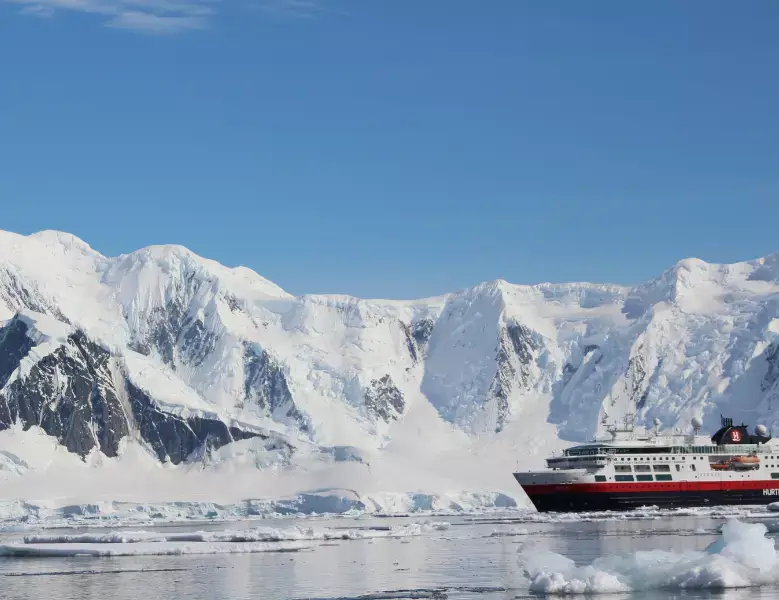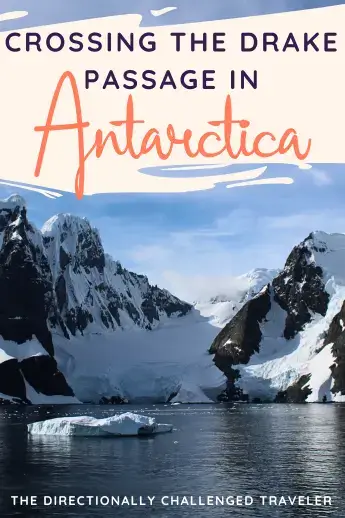How bad is Crossing the Drake Passage in Antarctica?
Antarctica / May 27, 2025 / 3 comments
This is probably the second most frequently asked question I’m asked about my trip to Antarctica (the first being – was it awesome? Yes. Yes it was.) A lot of people have heard horror stories about this infamous waterway and have hesitations about traveling to Antarctica because of it. It’s definitely a unique experience, but one that is definitely worth it. I figured I’d share my experience and hopefully ease some minds about crossing the Drake Passage!
I crossed the Drake Passage on Hurtigruten Cruises – a cruise line company that specializes in polar travel. Despite the rough seas, I never felt unsafe on the ship (and I didn’t even get sea sick – but that is more unusual).
What is the Drake Passage?
The Drake Passage is a treacherous body of water that lies between South America’s Cape Horn and the Antarctic Peninsula. It is notorious for its unpredictable weather and rough seas, and crossing it can be a daunting and exhilarating experience. For those who are adventurous enough to make the journey, traveling through the Drake Passage can be an unforgettable experience.

Where is the Drake Passage?
The Drake Passage is named after Sir Francis Drake, who was the first Englishman to sail through it in 1578. It is approximately 800 kilometers (500 miles) wide, and its waters are influenced by the strong westerly winds that circle the Antarctic continent. These winds can reach speeds of up to 120 km/h (75 mph) and are responsible for creating some of the roughest seas in the world.
Traveling through the Drake Passage is not for the faint-hearted. The journey can be challenging, with high waves and strong winds making it difficult to navigate. Many people experience seasickness, and the journey can be mentally and physically exhausting. However, for those who are up for the challenge, the rewards can be well worth it.
One of the biggest attractions of traveling through the Drake Passage is the opportunity to see some of the world’s most incredible wildlife. The waters of the Drake Passage are home to a vast array of marine life, including whales, dolphins, seals, and a variety of seabirds. It is also a popular route for Antarctic cruises, which offer the chance to explore the frozen continent and its unique ecosystem.
Despite its reputation for rough seas, the Drake Passage can also be surprisingly calm. When the weather is good, the journey can be relatively smooth, and travelers can enjoy stunning views of the surrounding seascape. On a clear day, it is possible to see icebergs and glaciers in the distance, adding to the sense of adventure and excitement.

History of the Drake Passage
The Drake Passage exploration began almost 500 years ago. It got its name after the British explorer Francis Drake’s ship was blow south of the Magellan Strait in 1578. He landed in those waters unexpectedly.
The first documented crossing of the Drake Passage was by the Dutch ship Eendracht in 1616. They rounded (what we now call) the Cape Horn.
Since that initial sailing, the Drake Passage has become infamous for rough seas. Those who have braved the crossing wear a badge of honor.

How dangerous is crossing the Drake Passage?
It’s important to remember that thanks to technology, ship construction, safety, and weather monitoring have all significantly improved. The fearful reputation of the Drake Passage stems from a time of wooden ships and no meteorology studies.
Today, we have a lot more information heading into the passage as well as advanced ship construction! Yes, you’ll probably get sea sick, but no the ship will not tip.

Do you have to cruise through the Drake Passage?
While taking a cruise from South America to Antarctica is the most common (and more economical), it’s not the only option. Since this is the narrowest passage connecting Antarctica to the rest of the world, most people leave from Ushuaia (or other points along South America). However, there are limited Antarctica options from Australia and New Zealand that would not go through the Drake Passage.
There are fly-cruise options that you fly over the Drake Passage and then cruise around Antarctica.

When do you take sea sickness medication?
Our captain made an announcement to let us know the next day we’ll be in the Drake Passage so to put on our Dramamine patches that evening. The patches take a little while to work, so you want to put them on before you get seasick. Mine ended up falling off while I was asleep, but I didn’t get nauseous, just unbalanced.
What is the Drake Shake?
The “Drake Shake” is a term of endearment for the waves. Most people are so excited to see the continent, that this time is a mixture of excitement and nausea. We had 12-foot swells, which was quite minor, on the way to Antarctica. On the way back, we ended up having a medical emergency and sped right through the Drake Passage. On the way home we crossed it in one day! No seasickness from anyone that I talked to.

What do you do while crossing the Drake Passage?
Ever see one of those videos where everything is falling over and it’s crazy on a cruise ship? This was not that. While our cruise with Hurtigruten had a total of 500 people on board, we had plenty of entertainment. The resident photographer gave us tips on how to shoot the wildlife, we had board games to play (though the puzzles were a bit rough), plenty of books in the library, and even the gym if you weren’t that nauseous. My favorite was the presentations – learning about this history of Antarctica and all the animals we’re going to see only made me that much more excited! Hurtigruten was amazing all around and you can read why I always recommend Hurtigruten.

Tips for Crossing the Drake Passage
- Be prepared with seasickness medication. I am comfortable on the water and I made sure to have it!
- Stay hydrated and fed! It’s important to keep food and liquids in – if you can’t, see the ship doctor. They have medications that can help you feel better.
- Lay down – Being horizontal can help you feel more balanced and thus, less seasick
- Get fresh air – the first thing people think of for seasickness is inside, but that’s not true. Looking out at the horizon can help you combat it.
- Keep occupied – attending presentations, interacting with others, etc will help the time pass quickly. Before you know it you’ll be in Antarctica!

Final Thoughts on Crossing the Drake Passage
In conclusion, traveling through the Drake Passage is a unique and unforgettable experience. It is a chance to see some of the world’s most incredible wildlife, to witness the power of nature, and to disconnect from the rest of the world. While the journey can be challenging, the rewards are well worth it. For those who are adventurous enough to make the journey, the Drake Passage is a destination like no other.
Save “Crossing the Drake Passage” for Later!
About the Author


3 responses to “How bad is Crossing the Drake Passage in Antarctica?”

I learned so much about this crossing. Glad to know it’s not too bad!

Eep! I have to admit, the idea of 12 ft waves (or worse) and the Drake Shake does not sound appealing BUT I would really love to see that scenery!! I can totally see why you wanted to give it a try anyway. Yay for the way back with no seasickness!

Yeah, even for me, who is pretty comfortable on the sea, it was a bit nerve wracking, but totally worth it!












Leave a Reply